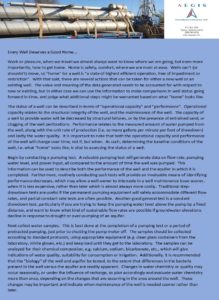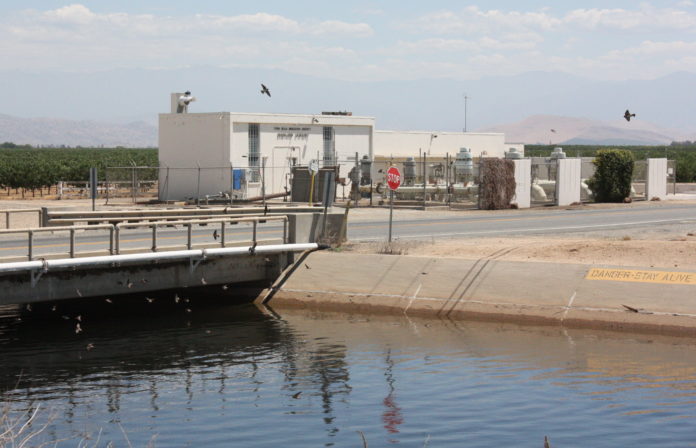Note: Our friend John Cox of the Bakersfield Californian wrote this piece recently and he and his publication kindly gave us permission to reprint the article.
By John Cox jcox@bakersfield.com
When it opened in 1951, the Friant-Kern Canal carried at least 4,000 cubic feet of water per second along its route from Millerton Lake, north of Fresno, to Bakersfield. Then something unfortunate happened.
A 25-mile stretch of land between Terra Bella and Pixley began to sink, and kept sinking, to the point that part of the canal’s gravity-powered water flow has slowed to about 1,700 cubic feet per second. The subsidence, caused by over-pumping of groundwater during drought years, means 60 percent less drinking and irrigation water can be delivered to communities along the 152-mile conveyance.
Federal and state officials would like to restore the canal to its original capacity, as would the seven municipalities and 18,000 family farms using the canal. But how? And where would money for repairs come from?
A bill introduced last week by state Sen. Melissa Hurtado, D-Sanger, proposes to take $400 million from California’s General Fund to fix the canal. Canal users have already contributed about $2 million toward the repair effort, while the federal government has invested about $7.4 million.
 Also, Rep. Kevin McCarthy, R-Bakersfield, last week proposed a bill that would free up additional money for canal repairs and other California water infrastructure by redirecting unspent federal money that had been set aside for the California High-Speed Rail Project.
Also, Rep. Kevin McCarthy, R-Bakersfield, last week proposed a bill that would free up additional money for canal repairs and other California water infrastructure by redirecting unspent federal money that had been set aside for the California High-Speed Rail Project.
THREE OPTIONS
Now, without knowing whether Hurtado’s bill will pass, the entity that maintains and operates the federally owned canal is looking at three very different options for repairing the structure. Which one ultimately is selected will likely depend on how much money ultimately becomes available for the project.
Probably the least expensive option, estimated to cost $150 million to $250 million, would expand the canal’s upper portion — the part visible from the surface — from about 60 feet to as much as double that width, but only along the 25-mile problem section.
Douglas DeFlitch, chief operating officer at the Friant Water Authority, headquartered in Lindsay, said widening the canal’s top would help by increasing conveyance capacity within what is now the structure’s fastest-flowing area.
“You’ve got a lot more space to move that water,” he said.
An alternative approach, estimated to cost about $400 million, would be to build a nearly identical canal adjacent to the existing one in the areas that have experienced the most subsidence.
The plan would be to cut a notch out of the structure so it could connect to the replacement canal, then tie back in to the existing structure once past the sunken area. The parallel canal would be built to drop at the originally designed slope of six inches per mile.
Engineering work on that design is about 30 percent complete, about the same as the less-expensive option.
DOWNTIME ALTERNATIVE
The third possibility under study by the authority is the one for which no firm price estimates exist. It would replace the canal along the entire 25-mile stretch that has experienced the most subsidence, perhaps using the existing structure’s banks.
A big drawback of that option is that, unlike the two alternatives, it would require shutting down the canal for an undetermined  but “significant” period of time, DeFlitch said.
but “significant” period of time, DeFlitch said.
“Those are the pluses and minuses we’ve got to consider as we move forward as part of this big project,” he said. “We’re still mixing and matching these options together to see.” DeFlitch offered a “ballpark” guess that the repairs could take 2 ½ to 3 years.
The water authority’s governing board is expected to review the options and rank them next month.
CONTINUING SUBSIDENCE
The wildcard in all of this is whether, or how much, ground under the canal will continue to subside.
Over drafting of water under the canal is supposed to end once state regulations contained in the Sustainable Groundwater Management Act take effect. But that’s not expected to happen until perhaps 2040.
Geotechnical modeling paid for by the water authority suggest the ground might continue to sink during the next 20 years. If all goes well, DeFlitch said, the ground won’t subside at all during that time. In the worst case, there will be another 4 feet of subsidence, he said.
BIPARTISAN PRIORITY
Meanwhile, Hurtado’s bill has received bipartisan backing. In addition to support from Democratic Assembly members, SB 559 is co-authored by two Republican state senators, Andreas Borgeas of Fresno and Devon Mathis of Visalia.
Hurtado asserted water infrastructure isn’t a partisan issue but an economic one that deserves votes from lawmakers across the state. Supplying water to more than a quarter of the valley’s agricultural land, the canal is integral to $4 billion per year in farming production, she said.
“It’s an investment for California because we’re talking about a major economic force that, if neglected, can just really make things worse for us as a state and our economy,” she said.
Assemblyman Rudy Salas, D-Bakersfield, agreed there is strong bipartisan support in the valley for water projects.
One reason is that overuse of groundwater has led to creation of the Sustainable Groundwater Management Act, which promises to put new limitations on the practice. That has raised awareness statewide about how dire the valley’s water challenges are, Salas said.
“If we can create sustainable water infrastructure to help move water around the state,” he said, “it’s going to benefit every Californian.”
John Cox can be reached at 661-395-7404. Follow him on Twitter: @TheThirdGraf. Sign up at Bakersfield.com for free newsletters about local business.
































